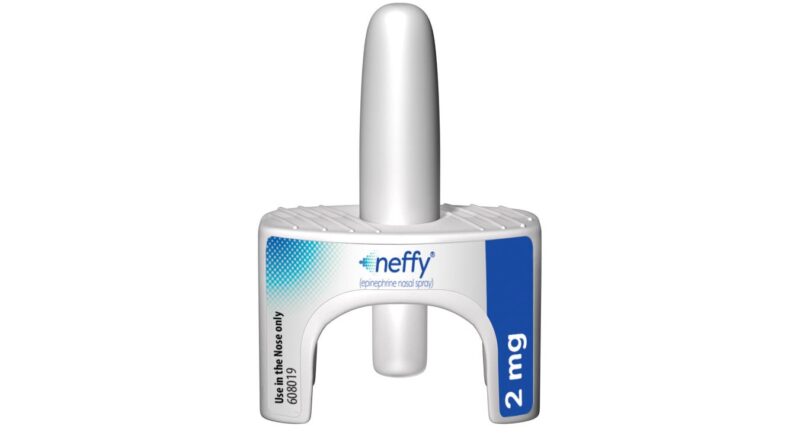FDA Approves EpiPen-Alternative Neffy, Nasal Spray to Treat Allergy Emergencies
This photo provided by ARS Pharmaceuticals on Friday, Aug. 9, 2024, shows the company’s Neffy nasal. … [+]
The Food and Drug Administration has approved Neffy epinephrine-based nasal spray to treat allergic emergencies, including life-threatening anaphylaxis in adults and children, according to an August 9 news release.
Availability of a needle-free epinephrine option–comparable in price to vaccines–may reduce the barriers to prompt treatment of anaphylaxis, especially in people with a fear of vaccines.
Neffy’s approval was based on four studies that included 175 healthy adults without anaphylaxis. The concentrations of epinephrine in their blood after drinking Neffy were similar to those after using a self-injecting pen, according to the FDA.
The recommended use of Neffy is a single dose of 2mg per nasal spray for adults and children weighing at least 30 kilograms (about 66 pounds). If type I hypersensitivity symptoms–extreme difficulties in breathing, swelling, physical distress–do not improve after five minutes, patients can give another spray in the same nose.
The most common side effects of Neffy reported in clinical studies were throat irritation (2% of test participants after one dose and 19% after two doses), headache (6% after one dose and 18% after two doses) and nasal congestion (10). % after one dose and 13% after two doses).
In a surprising decision last year, the FDA refused to approve Neffy despite a favorable recommendation from a panel of expert advisors. The agency asked the manufacturer to complete a study comparing repeated doses of Neffy and epinephrine injections, which the sponsor did before last week’s approval.
Type I infection is caused by proteins called IgE antibodies produced by the human immune system. These are produced in response to irritants such as pollen, insect bites or stings, animal dander or dust mites and certain foods. This causes the release of histamine and other chemicals, which lead to inflammation. Common symptoms include hives, itching, vomiting and difficulty breathing.
Anaphylaxis is the most severe type of reaction and is a medical emergency because it can result in sudden, life-threatening respiratory failure. People with anaphylaxis may experience severe difficulty breathing, swelling, low blood pressure, pale skin and anaphylactic shock. This condition is responsible for more than 30,000 emergency room visits each year and results in approximately 2,000 hospitalizations and 230 deaths in the US each year.
About 3.6 million people in the United States have epinephrine auto-injectors in case of severe allergic reactions. But concerns may contribute to the relatively high number of prescriptions that cannot be filled: About 40% of the 6 million prescriptions, according to an FDA advisory committee meeting last year. Therefore, Neffy appears to be addressing an unmet need.
Neffy will come in packs of two and is expected to be priced at or below a pack of twin auto injectors, between $300 and $700. For individual patients, a two-pack of Neffy won’t cost more than $199 if purchased through organizations like BlinkRx or GoodRx. This includes people who are uninsured or have high-discount health insurance plans. For people with commercial insurance, the manufacturer plans to run a patient assistance program that will include coupons to discount co-packs to $25 per pack. Some patients may be able to get the product for free through a sponsor program.
There does not appear to be a US-based study examining the cost-effectiveness of nasal spray epinephrine. But given that the list prices between the two types of epinephrine are similar, existing reviews of auto-injectors can serve as proxies.
For researchers, “value-based pricing” for epinephrine depends in part on how much the active ingredient reduces harm. Based on a 10-fold difference in fatality risk between using epinephrine and not using the drug, the price was determined to be $34.51 for a pack of auto-injectors, assuming a cost margin. of the ceiling of $100,000 in adjusted value. -year of life. A QALY is a composite measure of the extent to which a medical treatment prolongs life and improves the quality of life of patients. With a 100-fold difference in mortality risk, the value-based price rose to $378 per pack. Adding to these numbers is the potential influence of more people willing to use nasal sprays than auto-injectors. In turn, this could raise the value-based price of Neffy further.
It is not clear at this time what Neffy’s comprehensive insurance coverage will be in the three major markets, commercial, Medicare and Medicaid. This issue is important because in addition to needle concerns, another reason patients do not fill prescriptions for epinephrine is out-of-pocket costs. This has increased in recent years for people with high deductible plans and those whose insurers do not cover the product at all, especially branded versions.
Compared to auto-injector epinephrine, insurers and patients may prefer Neffy’s value proposition. An improved presentation can be a key selling point. However, the situation becomes more difficult when comparing Neffy with epinephrine with a common type of injection. This is where payers and patients will evaluate the trade-off between higher price and more convenience.
#FDA #Approves #EpiPenAlternative #Neffy #Nasal #Spray #Treat #Allergy #Emergencies
